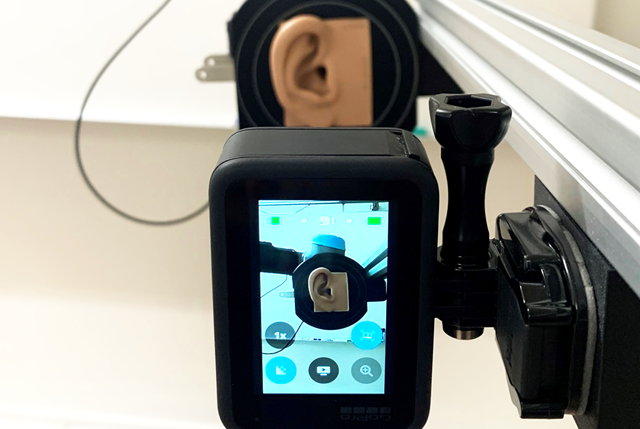Working up a sweat and racing pulses are all in a day’s work for researchers Tron Vedul Tronstad and Johannes Tjønnås. They’ve just reached the top after jogging up the long staircase outside NTNU’s Science Building at Gløshaugen in Trondheim. Gløshaugen is the epicentre of all kinds of research, and on this autumn day, Tronstad and Tjønnås are wearing their trainers, earbuds, sensors and a GoPro camera – all in the aid of a new research method.
They’re aiming to find out how earbud sound quality responds to movement and how well the buds stay in place during a variety of physical activities.
But how can they answer these questions with the necessary accuracy? These aren’t simply ‘run of the mill’ measurements, so the researchers have developed their own approach – which requires working together closely with a robot.
Turning a robot into an accurate copycat
What the researchers need first of all are data about movements within the ear itself while the wearer is performing different types of activity. This is why Tronstad and Tjønnås have been acting as their own guinea pigs, exercising in their trainers and equipped with their pulse watches, sensors and a camera.

SINTEF-researcher Tron Vedul Tronstad inspecting the equipment ahed of the tests.
Their efforts have produced a vast amount of data recording the movements that impact on an earbud as the wearer performs a variety of different activities at different speeds. They’ve done everything from walking and jogging at moderate speeds, as well as some really hard training.
“Even if the current approach is being applied to test earbuds used for listening to music, it can in principle also be applied to test anything that has to be fitted in and around the ear, such as a hearing aid”
The data then have to be digitalised so that the recorded movements can be repeated accurately by a robot – because it is the robot that will be carrying out the lion’s share of the high-volume training that constitutes the tests.
This means that a computer programme must be developed to enable the robot to convert the measurements into physical movements that it can perform for as long and as often as is necessary.
“Repeatability is very important”, says Tronstad. “We could have carried out the tests using human subjects, but they would have performed the movements differently every time, which would have made it difficult to compare the different types of earbuds. When the robot repeats exactly the same movements during every test, we can be sure that any differences we record are due to the earbuds, and not to differences in physical movement”, he says.

Some maths are neccesary as input to the robot…
An artificial ear, packed with sensors
However, it is also important to find out if physical movement impacts the sound quality. This is where the researchers can call on a familiar friend to help them out – an artificial ear, packed with sensors.
“What we’re doing now together with SINTEF is to develop an objective test method that is documentable and which can be used to measure both the sound and the sound suppression properties of an earbud while it is in motion”
“For many decades now, we’ve been working on a number of hearing-related projects, mostly focusing on hearing protection and protecting the ears”, says Tronstad. “In this field too, activity can affect the sound attenuation, but this isn’t something that we’ve investigated before. Our ear simulator consists of an anatomically accurate silicon ear fitted with a microphone where you would normally expect to find the eardrum. This enables us accurately to measure the sound emitted by an earbud or a headphone”, he says.

An artificial ear packed with sensors and a robot will test the earbuds. Photo: SINTEF
Creating an objective reference datum
The researchers are working for earbud manufacturer Freebit, which uses anatomical principles to develop technologies that help audio equipment companies to identify the most comfortably fitting earbuds. Freebit currently licences its technology to companies such as JBL and Audio-Technica.
The company is currently looking to offer an objective sound quality testing regime for earbuds.
Current tests are performed in laboratories using either static equipment or are based on subjective user experience. “What we’re doing now together with SINTEF is to develop an objective test method that is documentable and which can be used to measure both the sound and the sound suppression properties of an earbud while it is in motion”, says Vidar Sandanger at Freebit.
“Even if the current approach is being applied to test earbuds used for listening to music, it can in principle also be applied to test anything that has to be fitted in and around the ear, such as a hearing aid”, says SINTEF researcher Tron Vedul Tronstad. “Hopefully, this will lead to better products for consumers”, he says.

